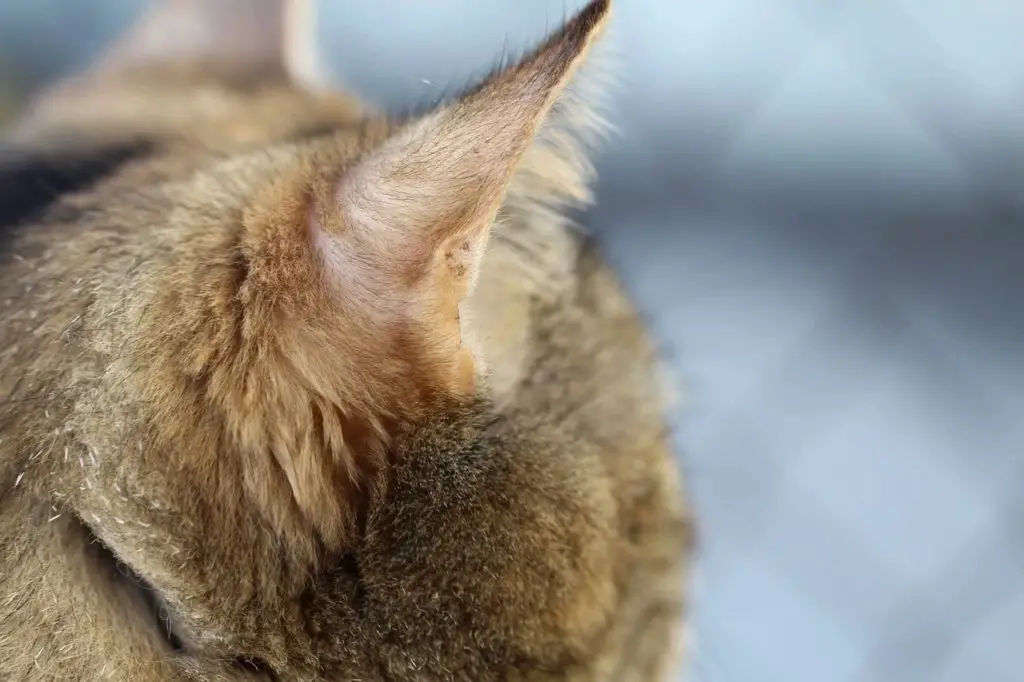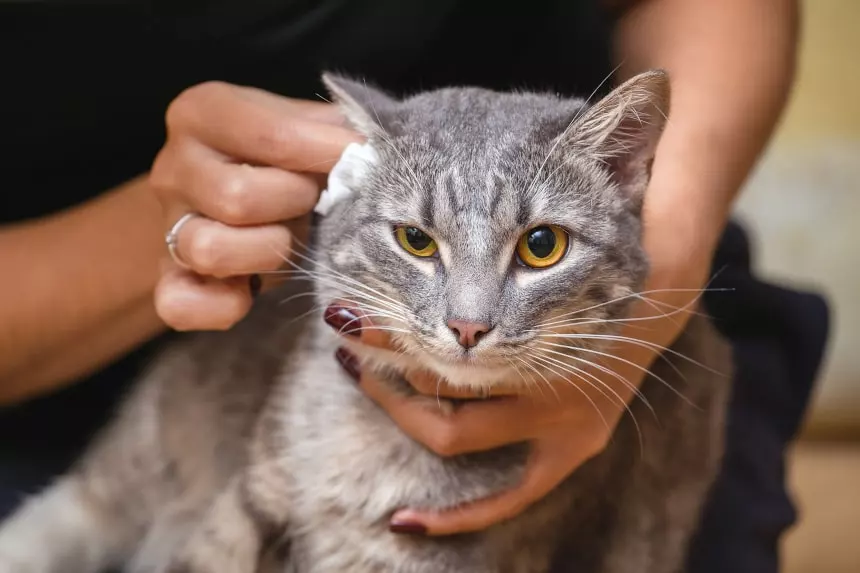I was petting my beloved cat today and in an idle moment of couch-sitting, I’ve realized my cats ears are hot! I’ve never really noticed this before, but now I am wondering – is this a problem? Are hot cat ears something to worry about? What should I do?
In the following article we will explain everything about this topic, and much more – how heat relates to cat’s overall body temperature, what you should do in case your cat has ear problems, and everything related!
Why Are My Cat’s Ears Hot To Touch?
The major difference why your cat’s ears and are hot to touch is because they are quite thin and do not have fur, compared to the rest of cat’s body. This means that cat’s ears are more easily exposed to heat and outside elements, and the same applies to their nose.
Hence, this is also one of the reasons why a lot of cats love sleeping on warm things!
Become a Smarter Cat Owner!
Get the free weekly email covering the latest cat news & research.
Bite-sized in just 5 minutes.
Cat’s body temperature also changes depending on the season and climate. The process of vasodilation, which means widening of blood vessels, increases the blood flow to these areas to release excess heat from the body. Similarly, during cold climate, the opposite occurs and blood vessels shrink to conserve the body’s heat. This process is called vasoconstriction.
Cats Natural Body Temperature
Naturally, cats are warm creatures and their body temperature is several degrees hotter than of any human’s. A cat’s natural body temperature is 102° F, which is a lot warmer than human’s body temperature of 98.6° F.
But also, cats have a much lower sensitivity to heat than humans do.
A human body can sense pain caused by heat 112° F or higher, unlike cats which can only sense pain from heat greater than 126° F. In addition, cats also have fewer areas on their bodies which they can sense heat, and they are mostly concentrated in their faces, which are highly receptive to heat.
Because of all of this, it is important to understand that the heat affects cats differently than humans. What may feel hot to us doesn’t feel so hot to cats, and doesn’t affect them in the same way.
Why Are My Cat’s Ears Hot And Itchy?
Do not be alarmed if you notice your cat’s easer feel hot to the touch. Most often than not, if your cat has been spending a lot of time out in the sun, or sleeping next to a radiator or a similar warm place, it makes perfect sense that this part of the body might feel warmer than usual, especially because cat’s ears do not contain fur, so they are warm up more quickly compared to the rest of their bodies.
However, when it comes to problematic situations, cats often going into hiding when they feel unwell and act reserved. Some of the potential causes of cat’s ears to be hot include:
- Exposure to a heat source: the most common cause of hot cat ears as we stated above could be simply from her laying out next to source of heat such as the sun or a radiator, but it can also be as simple as a cat’s paws that warm their ears. Furthermore, if a cat sleeps wraps her paws over her ears, her own body heat can easily increase the temperature. Once away from the source of heat, the temperature of cats ears should cool down.
- Fever: another reason why your cat might have hot ears is that she is suffering a fever. Cat’s immune response will naturally elevate its temperature in order to protect itself from the fever, and this includes cat’s ears.
- Infection: when a cat’s body part is warmer than normal for a prolonged period of time, it could mean an infection has been contracted.
- Allergy: cat’s ears can also be hot as the result of an allergic reaction, from various allergens such as food, leas bites, textiles and so on.
- Diseases: some specific ear diseases such may be the cause of the change in temperature.

Is There Something Wrong If My Cat Has Hot Ears?
Most likely, there is nothing wrong fi your cat has hot ears because cats are naturally hot and their normal body temperature is a few degrees hotter than a human’s. Anything up to 102.5 degrees Fahrenheit is normal for cats.
However, if you notice that cats are rubbing and scratching their ears, hiding or experiencing hearing loss, then that’s likely a different story – make sure to take your cat to a veterinarian and investigate for any underlaying conditions!
Does A Cat With Hot Ears Mean Fever?
Even if your cat suffers from standard fever from 103.5 degrees Fahrenheit, it is not really a cause for concern. The increase in heat that their body experiences during fever is their body’s natural way of fighting infection causing virus or bacteria. It gives a boost to their immune system to fight diseases.
An important fact to note is that a cat suffering from fever will choose to isolate themselves in a cool place and will not be curled up in your lap.
If you are concerned about your cat’s temperature then feel their stomach and underarms. If that is also hot then they could be suffering from fever. As a cat with fever will experience a raised temperature evenly across their body. Seek immediate help from the vet if you notice no change in their condition for the next two days. Other symptoms like change in appetite, lethargy and restlessness will be evident. They will require swift medical intervention in this case.
Hot Cat Ears And Viral Infections
Fevers caused by viral infections in cats may subside as quickly as they arise. Fevers caused by secondary bacterial infections are usually accompanied by wounds that you can easily observe or can be indicated by unnatural areas of swelling if they are internal.
If your cat has experienced feverish conditions four or more times over the course of two weeks, the cat may have what is referred to as a fever of unknown origin. Make careful note of any and all changes — behavioral, physical and otherwise, including the first time you noticed hot cat ears. That way your vet can begin the difficult process of identifying the problem.

Cat Ear Temperature And Ear Infections
The most common cat ear issue is otitis externa, commonly known as the infection of the outer ear. Cat ear infections are most frequently traced to yeast infections and ear mites. Almost always, mites are the problem in the majority of reported cases.
Ear infections may occur with ears that are warmer than normal but almost always only when the cat is paying attention to them than usual, which should be very easy to spot. Abnormal amounts of ear scratching with their paws, or rubbing them against furniture, will raise their temperature and cause cat’s ears color change to red from natural pink. In general, symptoms of an ear infection would follow a change of color along with a strange and pungent smell.
What Are The Symptoms Of Cat Ear Issues?
If your cat’s ears look red or sore, your cat is scratching them or rubbing their ears on the furniture or the floor, which means there is likely to be a problem.
However, not all problems are visible. Many cats develop some sort of hearing loss as they get older. Your cat might not be responding to noises in the same way they used to because they’ve lost there hearing, but this isn’t an issue for most cats, and there is nothing you can do about it.
If you think your cat is losing their hearing, ask the veterinarian to give them a check-up and they can investigate and make sure there isn’t another cause.
How Should I Check My Cat’s Ears?
The best way to monitor your cat’s ears is to look at them while you are petting your cat. You should be able to spot very easily if there is something wrong with your cat’s ears, such as an infection.
However, we would like to point out that cat’s ears are very delicate. Please do not touch the inside of your cat’s ears while grooming your cat, or insert anything inside cat’s ears. Your cats might not enjoy this, and it might be very discomforting for them, just as it would be for you.
What Do Healthy Cat Ears Look Like?
Healthy cat ears should be clean, and they should not smell. In a healthy cat, there should be no visible redness, hair loss from around the ears, or change of color. Healthy cat ears are of pink color and clean inside.
Leave a Comment